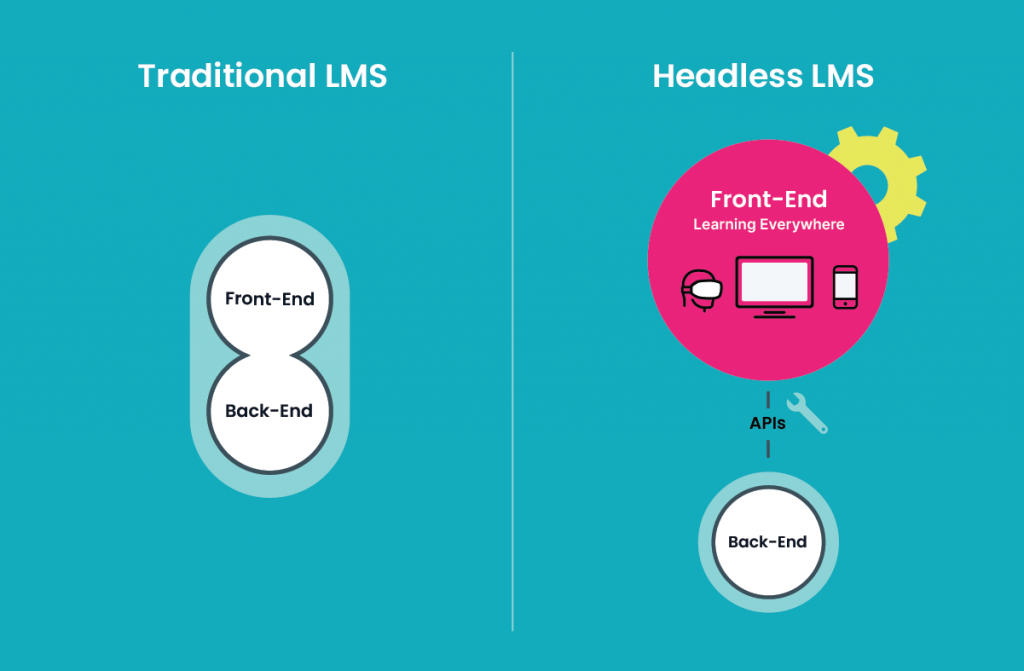What is Headless LMS?
The rise of on-demand eLearning content has brought with it a need for impactful digital experiences. For customer education teams and learning businesses, being able to design and deliver a highly contextual, dynamic, and personalized experience – without having to stay inside the rigid boundaries of a learning management system (LMS) – is an exciting prospect.
As we’ve witnessed in recent years in the content management and eCommerce industries, creating a fully custom front-end experience on top of back-end software and services can completely revolutionize the way businesses use a platform. Vendors in these industries who can’t accommodate this capability are falling short, as “headless” competitors are gaining steam and market share.
What any digital content provider can benefit from – especially in the learning industry – is full control over how, where, and when users access and engage in the experience.
Enter: The headless LMS.
A headless LMS is a learning platform that decouples the front-end presentation layer from the back-end services – in other words, an organization is able to build their own front-end user experience on top of the foundational LMS solution, then extend it out to different channels and devices. A headless LMS software solution delivers powerful back-end functionality, and leaves the front-end display layer completely up to the customer, according to delivery channels, brand standards and ultimate look and feel.

Where a Traditional LMS Falls Short
While a traditional LMS might aim to be the single solution for both back-end functionality and front-end learner experience, a headless LMS is built with flexibility and extensibility in mind – opening the doors on what’s possible in the industry.
Here are a few ways a traditional LMS will quickly fall behind as the rise of headless technology takes off:
Limited Customization
The goal of a headless platform is to provide ultimate flexibility by opening the door on what’s possible for the front-end learning experience – without that ability, organizations are limited to what comes “out of the box” of a traditional learning platform. How the user experience is put together comes in one option, and customizing it means more time (and money) spent by organizations using it. These traditional platforms were architected and designed as single, “monolithic” systems making the separation of front-end and back-end functionality impossible leading to limited options when it comes to learner experiences.
Only Web and HTML Delivery Options
With a traditional LMS, often the back-end and front-end functionality are so tightly coupled, that not only do users miss out on customization options and building the experience they want, they also are left with a singular way to deliver learning. Almost all traditional LMS platforms operate with web and HTML options – and not much else. For organizations who have learning needs beyond a web interface, this will become outdated very quickly.
Afterthought APIs
Many LMS platforms are built with a certain amount of extensibility in mind, but they often hit a wall when it comes to delivering the right functionality to every customer. For example, integration to Salesforce or other common CRM platforms is key for customers seeking better data and reporting. But, as soon as you need to deviate outside the boundaries of basic integration, vendors’ extensibility capabilities through their APIs start to show their shortcomings. Worse yet, many integration requirements will require new API endpoints be built by the vendor leaving you with dependencies outside of your control.
The Advantages of Going Headless
In contrast to the potential drawbacks of a traditional learning platform, a headless LMS provides an organization with total control of the learning experience, while also being able to leverage pre-built back-end services along with more options and freedom to build out custom integrations that meet your business needs.
“Every organization already has existing business processes and systems in place that a new LMS will need to seamlessly integrate with and support,” says John Leh, CEO and Lead Analyst at Talented Learning. “Ideally, organizations can find off-the-shelf LMS solutions to do everything they need. Many times though, especially in customer learning and learning-as-a-business applications, the level of complexity, the technical ecosystem, and a desire for custom experiences drive the need for tools and strategic vendor guidance to change and customize the application without impacting the update and upgrade path.”
This level of customization power may not be the right fit for every company, but there are many advantages to adopting an LMS with a headless architecture:
- Creativity is unlocked for designers and developers. Disconnecting the back-end functionality from the front-end allows an organization’s in-house designers and developers to have true creative freedom over the learning experience. This means, with a headless platform, an organization is given the freedom and space to create a tailored learner experience that’s perfectly aligned with the design vision.
- Endless omnichannel learning options become possible. With the ceiling removed on when, where, and how organizations can deliver eLearning content, it becomes more about reaching learners in context – whenever and wherever they are. This means organizations can use the delivery method to bring that experience closer and closer to the learner’s true moment of need. Think: native mobile experiences, augmented reality, virtual reality, and other embedded systems that power screens and devices across a multitude of consumer products.
- Learning strategy becomes future-proof. Without limits on when, how, and where you deliver learning, your program or learning business can easily grow and scale over time without any worry about needing to upgrade and migrate to a platform that can support new delivery channels. More options may seem daunting in early stages, but two or three years down the road, a headless LMS will enable organizations to really hone what they want out of their learning software.
How do I Know Headless LMS is Right for My Organization?
Opting for a headless LMS is certainly a more appealing decision for organizations with specific design and branding needs, or a focus on creating differentiated learning experiences across multiple delivery channels. Most importantly, adopting a headless platform requires an organization to have access to in-house or external development resources to build their ultimate vision.
So, if you’re contemplating a headless LMS solution, here are 3 key use cases that make headless a perfect fit:
- Learners with alternative delivery needs: For some organizations, learners simply aren’t in front of a computer and web browser as part of their day-to-day. In this case, a learning platform that can support native experiences across any platform or system is key. You have to start with the question, “Where are my learners, and where would a learning experience be most effective?”
- Organizations with specialized design needs: Businesses with very specific design and brand requirements – or ambitious design aspirations for their learning experience – will likely never come across an out-of-the-box LMS solution that works perfectly for them. A headless experience ensures these teams will end up with the perfect front-end learner interface for their needs.
- Businesses with a home-grown LMS: For companies looking to migrate from an internally developed system to utilize a platform from a commercial LMS vendor, a headless LMS could be an ideal choice. Given that internal development resources exist, and the common desire to reuse existing functionality from the home grown system, a headless LMS provides the freedom and extensibility that is needed to do so, along with the peace of mind around control that comes with that.
Even if your organization doesn’t yet fall into any of these categories, a headless LMS also offers a much higher level of customization when it comes to data integration and organization – which can be a huge competitive edge for any team.
“Opportunities for headless LMS are becoming more common,” says John Leh. “Often, organizations want to have granular control of the look and feel of the platform, but more importantly, they want to bring data in from other ecosystem sources and use that data to drive actions in the learning system – such as content availability and assignment. The “headless” LMS experience allows buyers to combine business and training data and processes in unique ways never envisioned, but enabled, by the vendor.”
Working with a vendor that understands your ultimate goals with the platform – and can help guide you on a strategic level – can also make the jump to headless LMS less daunting. And, as the trend of a headless learning platform grows and evolves, organizations will have access to more and more examples of great headless use cases, and begin to see how they can harness this exciting functionality for their own business success.



